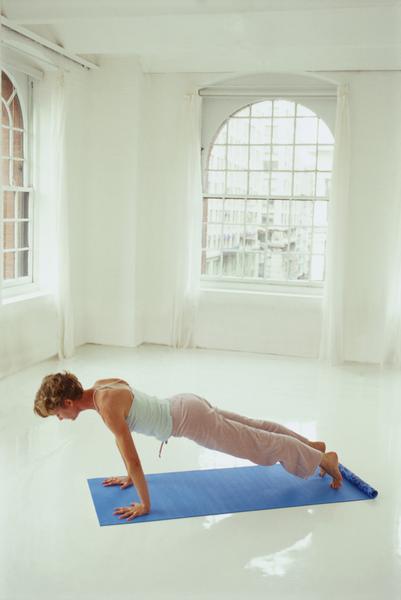
Originally Published on Woman: The Nest
If you’ve ever seen a mime trying to escape his invisible box, you’ve seen a playful example of an isometric contraction. Isometric exercises are strength-training exercises that involve the contraction of a muscle against an immovable resistance. While the mime’s resistance is imaginary, you use the floor for resistance when doing an isometric plank. The isometric plank exercise provides core stability, improves posture and protects your lower back.
Same Length
“Iso” means same and “metric” means length, so isometric literally means “same length.” The static tension of isometric exercise strengthens the muscles at the same length — in the position in which they are held. This can be beneficial when rehabilitating an injured joint or as a technique to improve fluid movement by overcoming weaknesses within a range of motion. It’s also a good exercise technique for training the core muscles, which often must remain stable as your arms and legs move. Because isometric exercises don’t move the joint through a full range of motion, you should hold isometric contractions in various positions and at varying angles to obtain maximum benefit.
How to Do an Isometric Plank
Start with a half plank. Lie on your stomach with your elbows on the floor, directly below your shoulders. Engage your abdominal muscles to stabilize your torso and keep your back from arching and lift your body off the floor. You should be balanced between your knees and elbows with a straight back. To do a full plank, lie on your stomach like you did for the half plank but flex your ankles so your toes are on the floor. Lift your body off the floor so you are balanced between your toes and elbows. Again, your body should be in a straight line. Once you can hold the plank position for a full minute, place your hands directly below your shoulders, palms down, and push up to balance on your toes and palms as if you’re at the top of a pushup. You can increase the challenge even more at this point by lifting one foot off the floor. And don’t forget to breathe as you hold the plank so your blood pressure doesn’t rise.
Muscles Worked
To safely maintain the plank pose, you have to pull your belly button up toward your spine. This action, called abdominal hollowing, activates the deeper, stabilizing muscles of the core. The muscles that benefit most from an isometric plank are the transverse abdominis, obliques, rectus abdominis and erector spinae. Depending on the position you hold, the plank pose may also strengthen muscles in your wrists, arms, shoulders, chest, feet, legs and buttocks.
Back Support
Support for your back requires stability throughout the core. Many people who suffer from chronic lower-back pain have weak core abdominal muscles. The deepest abdominal muscles, the transverse abdominis, stabilizes the lower back before movement of your arms and legs occurs. This function is critical to avoid excessive or unnatural movement of the joints in your lower back. You contract this muscle when you hollow your abdominals in the plank pose. The inability to maintain an isometric contraction of this muscle leads to poor posture and overuse of other muscles, which can cause back pain. Regular training of the core, including doing the isometric plank exercise, can help overcome these imbalances.
References
- Positive Health Online: Transverse Abdominis (TVA) and its Function in Lower Back Stability
- American Council on Exercise: New Study Puts the Crunch on Ineffective Ab Exercises
- American Council on Exercise: Front Plank
About the Author
Cindy Killip is a medical exercise specialist, health coach, author and speaker who has been teaching and writing about exercise and wellness since 1989. She authored the book Living the BONES Lifestyle: A Practical Guide to Conquering the Fear of Osteoporosis [2012]. Killip received certifications as a medical exercise specialist, health coach, personal trainer, and group fitness instructor through the American Council on Exercise, and degrees in communications and sociology from Trinity University with a focus on pre-med and exercise science/lifetime fitness. She studied exercise physiology at the University of New Mexico graduate school.
Original article published on Woman: The Nest



